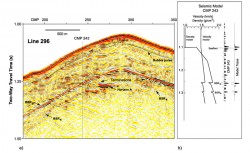Institute Pioneers Research on Hydrates
April 12, 2008

<< Return to ‘Exploration & Innovation’…
Researchers at the Jackson School’s Institute for Geophysics have a distinguished track record of basic research on gas hydrates, from pioneering the earliest efforts at detecting them to advancing our understanding of their vertical orientation in venting systems and addressing critical questions on their potential release due to warming oceans.
Tom Shipley, a senior research scientist at the Institute, was one of the first to clarify the properties of the geophysical diagnostic of the presence of hydrates, the Bottom Simulating Reflector, or BSR. People were collecting seismic data for a long time and did not know what the BSRs were, said Nathan Bangs, Shipley’s colleague at the Institute. “Tom is the one who figured out what they were,” said Bangs. “Some people on the geochemistry side were working on the same issue—they came together and showed the BSR was related to a phase change between methane in the hydrate form and the free gas form.”
The prolific Shipley has authored or co-authored more than 80 papers, but one of his most cited remains his 1979 report on hydrates for the AAPG Bulletin, “Evidence for widespread possible gas hydrate horizons on continental slopes and rises.”

Early estimates of vast quantities of hydrates, based in part on the discovery of the BSR, proved to be way too high. “It was assumed that all the pore space from the seafloor down to the BSR was filled with hydrate,” said Bangs. “We’ve since learned there are a lot of places where you get good strong BSRs and not much hydrate associated with them.”
Interest in hydrate concentrations has renewed over the past several years, however, after researchers at the Institute and colleagues working through the Ocean Drilling Program discovered that hydrates typically form in fractures. “Places that have gas venting systems seem to be where hydrates have the highest concentrations,” said Bangs, “and gas venting systems tend to fill vertical fractures.”
Discovery of hydrates’ vertical orientation “gives new life to the possibility there are more hydrates than we might have expected, more highly concentrated and placed in a way we did not appreciate before,” said Bangs. “It also shows us where to look for them.” Bangs’ Institute colleague Matthew Hornbach was able to document the vertical orientation of hydrates off Blake Ridge in North Carolina.
Some of Bangs’ own recent work on hydrates addressed a major environmental concern: that warming seas could melt gas hydrates leading to the release of massive quantities of methane into the oceans and possibly the atmosphere. In research at Hydrate Ridge off the coast of Oregon, Bangs found evidence of what he concluded was an earlier warming and release of methane from hydrate. The indicator was a double BSR—an upper BSR marking the current hydrate boundary and a lower one marking an earlier boundary. In a paper published in 2005 in the Journal of Geophysical Research, Bangs showed that temperatures propagated upwards and causing the BSR to shift up. Hydrate melted and left behind a BSR signal that persisted for 5,000 years. Bangs believes it was related to the last glacial maximum and warming since then. The lingering BSR is slowly dissipating.
“That’s a good indicator hydrate does not move very fast through the sediments in this setting,” said Bangs. The incident is just one example, but in that example, at least, hydrate appears to have reconstituted higher up on the ocean floor rather than release massive quantities of methane.—J.B. Bird
<< Return to ‘Exploration & Innovation’…
For more information about the Jackson School contact J.B. Bird at jbird@jsg.utexas.edu, 512-232-9623.
